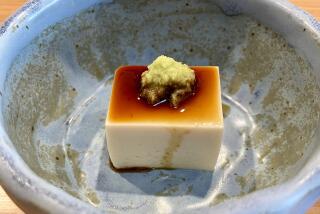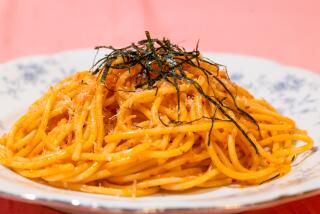Emperor’s Brew an Uncommon Mixture
- Share via
NODA, Japan — The emperor’s soy sauce is ready.
The beans have fermented a full year in huge wooden vats. Workers have strained the sauce by hand through pure cotton filters. Tasters have given their nods of approval.
Now bring a saucer of the amber liquid to your lips and see for yourself: a single drop fills your mouth with flavor. Hours later, the salty tang still lingers in your throat.
Soy sauce is just a seasoning to most folks. But at Kikkoman Corp., the world’s biggest producer, it’s much more: a brew fit for gods, the backbone of East Asian cuisine, even a unifier of nations.
“We are selling soy sauce to 100 countries,” Kikkoman President Yuzaburo Mogi said in an interview. “If people in the world have a common experience in food, they can be more friendly.”
If there’s any place suited to soy sauce hyperbole, it’s Noda, a hamlet 20 miles north of Tokyo that has been the center of Japanese soy sauce production for centuries.
The thick aroma of fermenting soy beans wafts over the town. Visitors to Kikkoman’s factories are given white caps as protection from floating bean dust.
In Noda, soy sauce is described in terms reserved for aesthetic cults like the tea ceremony or cherry blossoms.
“Soy sauce reveals a complex yet delicate world of taste,” assures a promotional film at Kikkoman, which features atmospheric shots of waterfalls and close-ups of meat soaked in soy sauce.
The pinnacle of Kikkoman’s soy empire is Goyogura, a special all-domestic batch brewed for the ultimate Japanese palate: that of the emperor himself.
The imperial sauce differs from the regular stuff in crucial ways.
First, while sauce made from imported soybeans and wheat is good enough for regular folks, the imperial family’s supply is brewed from purely made-in-Japan ingredients.
The two sauces go through the same initial mixing steps, but the imperial family’s brew is moved in the middle of the process to a traditional, tile-roofed factory beside the Edo River.
There the concoction is fermented the old-fashioned way: not for just six months in steel containers, but for an entire year in huge wood vats, where it is stirred and strained by hand.
Even for soy sauce neophytes, the difference is clear. The imperial brew delivers a powerful, full-bodied punch to the taste buds. The regular sauce is tame by comparison.
Introduced from China some 500 years ago and adapted to Japanese tastes, the flavoring became indispensable by the 1600s. Everything from sushi to noodles, from tempura to teriyaki, has a dash of it.
As the world’s largest soy sauce producer, Kikkoman has annual revenues of nearly $2 billion and its Noda plants alone turn out a million 1-liter bottles of sauce every day.
More to Read
Eat your way across L.A.
Get our weekly Tasting Notes newsletter for reviews, news and more.
You may occasionally receive promotional content from the Los Angeles Times.










